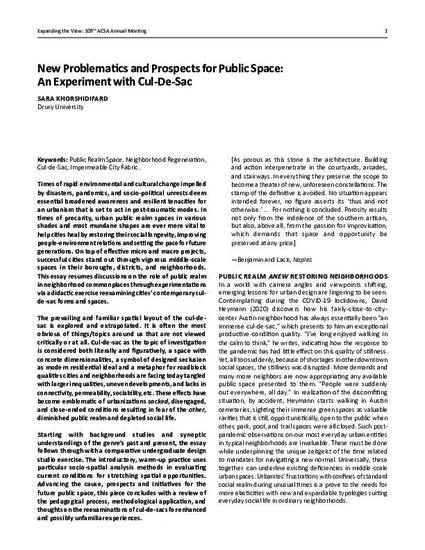
Article
New Problematics and Prospects for Public Space: An Experiment with Cul-De-Sac
2021 ACSA 109th Annual Meeting: Expanding the View: Prospect(s) for Architectural Education Futures, March 24-26, 2021, Virtual Saint Louis, MO
(2021)
Abstract
Times of rapid environmental and cultural change impelled by disasters, pandemics, and social unrests deem essential a broadened awareness and vocabulary of resilient urbanism with protean tenacities to act in post-traumatic modes. Public spaces in various shades are vital, even more than before, in binding city/town fabrics together and helping them heal. As overarching theme, this paper explores new problematics and prospects at rise in ranges of semipublic-to-public spaces, tapering the focus on rethinking a familiar space layout: contemporary cul-de-sac. Reexaminations concentrate on questioning the current morphology, seeking ways to stretch architectural and urban design opportunities, and recreating this familiar environment to be experienced in enhanced, possibly unfamiliar, ways. Better cities offer better public spaces/places at all and multiple scales, including in the middle. In addition to desirable individual buildings and sites in micro scales as well as effective urban infrastructures and schemes at macro scales, successful cities distinguish through vigorous middle scales. That includes what lies within their public space ranges in their boroughs, districts, and neighborhoods. Typical neighborhood units are important components where cul-de-sacs belong. While middle scales are worked out to best fit for human-scale and user-experience in some, those are typically taken for granted, remaining not at focal attention in average cities. This study takes a “recipe” approach to reclaim and revive middle/neighborhood spaces, a not-one-size-fit-all approach, in this paper, taking on cul-de-sac reimagining to be enriched as protean public spaces via mixing ingredients. The Cul-De-Sac Experiment: Contemporary cul-de-sacs are diverging, looped or circular no-through street patterns within (sub)urban sprawls, chunking out superblocks’ built-up fabrics into isolated components with introverted pathway networks. Cul-de-sacs are widely studied and debated from multiple standpoints (Hochschild 2015; Charmes 2010; Morrow‐Jones, Irwin, and Roe 2004; Cozens and Hillier 2008; Southworth and Ben-Joseph 2004). This study’s background research revisits broader concepts/methods of street and public realm studies (Gehl and Svarre 2013; Gehl 2011; Appleyard and Lintell 1972), sociological theories (Gibson 1977; Klinenberg 2018), and summary understandings of typological history. The paper contributes knowledge, expanding and complicating the archetypical morphology, asking: what historic/global equals have been, how patterns came to be, what are likes or dislikes, and how it could be readjusted in path forwards for public space reimagining. Conclusions present loose-fit adaptable design speculations discursively, diagrammatically, and contextually, appending to cul-de-sacs more flexibility and protean qualities. The methodology records analyses and syntheses of ten randomly selected, existing cul-de-sac case studies from throughout a mid-size, Midwestern American city. Cases vary in terms of permeability, neighborhood socio-economics and use characteristics (completely or partly residential, university campus, etc.). The sample is explored in a design studio, factoring in accessibility, connectivity, movement, sociability and desirability. The research process engages eye-level observations, user-counting, tracking, mapping, and tracing, naming a few. Results are curated in form of infographics that are charted on a greater city plot. Outcomes contribute illustrations to ways of public space reimagining by ways of entrenching flexibility and protean qualities on the way to middle-scale, neighborhood resiliency.
Disciplines
Publication Date
Spring March 26, 2021
DOI
https://www.acsa-arch.org/conference/109th-annual-meeting/schedule-abstracts-friday/#toggle-id-20
Citation Information
Sara Khorshidifard. "New Problematics and Prospects for Public Space: An Experiment with Cul-De-Sac" 2021 ACSA 109th Annual Meeting: Expanding the View: Prospect(s) for Architectural Education Futures, March 24-26, 2021, Virtual Saint Louis, MO (2021) Available at: http://works.bepress.com/sara_khorshidifard/38/
Creative Commons license

This work is licensed under a Creative Commons CC_BY-NC-ND International License.
